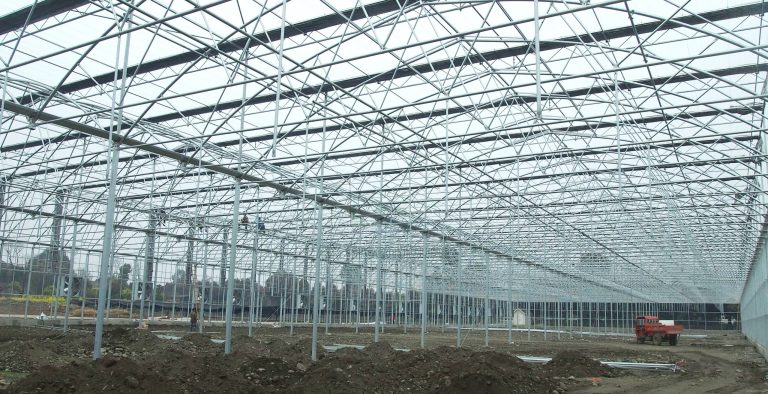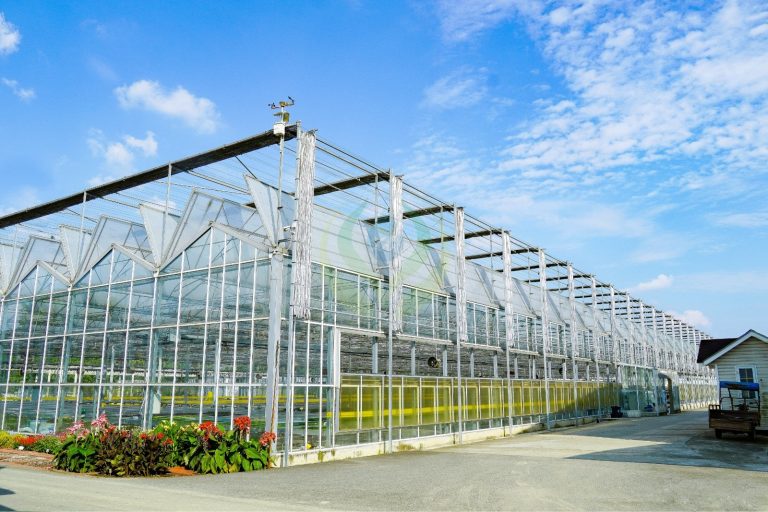Greenhouse structures are essential for creating a controlled environment that supports plant growth. However, like any construction, greenhouse structures can encounter various problems that may affect their functionality, durability, and the health of the plants inside. Understanding these potential structural issues can help you prevent, identify, and address them effectively. Here are some of the most common structural problems associated with greenhouses:
1. Frame Weakness and Instability
Issues:
- Material Degradation: Frames made from materials like wood can rot, while metal frames may corrode over time, especially in humid environments.
- Inadequate Support: Poorly designed or constructed frames may not withstand environmental stresses such as high winds, heavy snow, or the weight of the covering material.
- Joint Failures: Weak or improperly secured joints can lead to gaps or complete frame collapse.
Solutions:
- Choose Durable Materials: Opt for corrosion-resistant metals like aluminum or galvanized steel, or use treated wood to prolong the frame’s lifespan.
- Regular Inspections: Periodically check for signs of wear, rot, or corrosion and address issues promptly.
- Reinforce Joints: Use strong fasteners and reinforcement techniques to ensure all joints are secure and stable.
2. Covering Material Problems
Issues:
- Cracks and Tears: The covering (glass, polycarbonate, polyethylene film) can develop cracks, tears, or holes due to weather impacts or physical damage.
- Poor Installation: Improperly installed coverings can lead to leaks, reduced light transmission, and increased vulnerability to pests.
- UV Degradation: Some materials may degrade or lose transparency when exposed to prolonged UV radiation.
Solutions:
- Select Appropriate Materials: Choose coverings that are durable and suitable for your climate. Polycarbonate and fiberglass are more resilient than polyethylene film.
- Proper Installation: Ensure coverings are tightly and correctly installed, with no gaps or loose sections.
- Regular Maintenance: Inspect the covering regularly and replace any damaged sections to maintain structural integrity and light quality.
3. Foundation and Base Issues
Issues:
- Uneven Ground: An uneven foundation can cause stress on the greenhouse structure, leading to warping or collapse.
- Poor Drainage: Inadequate drainage around the base can lead to water pooling, which can weaken the foundation and cause flooding inside the greenhouse.
- Insufficient Anchoring: If the greenhouse is not properly anchored to the ground, it may shift or collapse during strong winds or storms.
Solutions:
- Prepare a Solid Foundation: Use a level and stable base such as concrete, gravel, or treated wood to support the greenhouse.
- Implement Proper Drainage: Ensure that water drains away from the foundation to prevent pooling and erosion.
- Secure Anchoring: Use appropriate anchoring systems (stakes, ground screws, or concrete footings) to firmly attach the greenhouse to the ground.
4. Ventilation and Insulation Challenges
Issues:
- Inadequate Ventilation: Poor airflow can lead to overheating, high humidity, and increased risk of diseases.
- Insufficient Insulation: Lack of proper insulation can result in temperature fluctuations, making it difficult to maintain a stable environment for plants.
- Air Leaks: Gaps or poorly sealed vents can cause unwanted air exchange, compromising the internal climate control.
Solutions:
- Install Adequate Ventilation: Use vents, fans, and automated ventilation systems to maintain proper airflow and temperature.
- Enhance Insulation: Use double-layered coverings, thermal screens, or insulating materials to stabilize internal temperatures.
- Seal Gaps: Ensure all vents, doors, and windows are properly sealed to prevent air leaks while allowing necessary ventilation.
5. Waterproofing and Drainage Problems
Issues:
- Leaks: Water can infiltrate the greenhouse through gaps, cracks, or improperly sealed joints, leading to water damage and plant stress.
- Poor Internal Drainage: Without proper drainage systems, excess water can accumulate inside, causing root rot and other moisture-related issues.
- Condensation: High humidity can lead to condensation on the coverings, which may drip onto plants and promote fungal growth.
Solutions:
- Ensure Tight Sealing: Use weatherstripping and sealants around doors, windows, and joints to prevent water ingress.
- Implement Drainage Systems: Install gutters, downspouts, and internal drainage systems to direct excess water away from plants and the structure.
- Manage Humidity: Use dehumidifiers or proper ventilation to control humidity levels and reduce condensation.
6. Stability in Extreme Weather Conditions
Issues:
- High Winds: Strong winds can exert significant pressure on the greenhouse structure, potentially causing damage or collapse.
- Heavy Snow Loads: Accumulation of snow can add excessive weight to the roof, leading to structural failure if not properly designed.
- Temperature Extremes: Rapid temperature changes can cause materials to expand or contract, leading to cracks or warping.
Solutions:
- Design for Local Climate: Ensure the greenhouse is designed to withstand typical weather conditions in your area, including wind speeds and snow loads.
- Reinforce the Structure: Use sturdy materials and reinforce critical points to enhance the greenhouse’s ability to resist extreme weather.
- Regular Maintenance: Clear snow from the roof promptly and inspect the structure after severe weather to address any damage.
7. Access and Door Issues
Issues:
- Improperly Fitted Doors: Doors that do not close properly can lead to drafts, temperature loss, and pest entry.
- Security Concerns: Easily accessible doors without proper locks can make the greenhouse vulnerable to theft or vandalism.
- Inconvenient Placement: Poorly placed doors can disrupt the flow of movement and make accessing different parts of the greenhouse difficult.
Solutions:
- Install Quality Doors: Use well-fitting, insulated doors that seal tightly when closed.
- Enhance Security: Install sturdy locks and consider additional security measures such as alarms or cameras.
- Strategic Placement: Position doors for easy access without compromising the structural integrity or internal layout of the greenhouse.
8. Integration with Other Systems
Issues:
- Poor System Integration: Difficulty integrating heating, cooling, irrigation, and lighting systems can lead to inefficiencies and structural strain.
- Electrical Hazards: Improper installation of electrical systems for lights, fans, and heaters can pose safety risks.
- Space Constraints: Overcrowding the greenhouse with too many systems can reduce usable space and hinder plant growth.
Solutions:
- Plan System Integration Carefully: Design the greenhouse layout with system integration in mind, ensuring that heating, cooling, and irrigation systems work harmoniously.
- Hire Professionals: For complex electrical installations, consider hiring a licensed electrician to ensure safety and compliance with local codes.
- Optimize Space: Arrange systems in a way that maximizes space efficiency and does not interfere with plant placement or movement within the greenhouse.
9. Pest and Vermin Intrusion
Issues:
- Entry Points: Gaps, cracks, and poorly sealed doors can allow pests and vermin to enter the greenhouse, damaging plants and potentially compromising structural elements.
- Material Damage: Certain pests, like termites or rodents, can cause structural damage by chewing through materials or nesting within the greenhouse.
Solutions:
- Seal Entry Points: Regularly inspect and seal any gaps or cracks in the greenhouse structure to prevent pest entry.
- Implement Pest Control Measures: Use physical barriers, traps, or natural pest repellents to manage and reduce pest populations.
- Regular Inspections: Conduct frequent inspections for signs of pest activity and address issues promptly to prevent infestations.
10. Maintenance Challenges
Issues:
- Accessibility: Poorly designed structures can make accessing certain parts of the greenhouse difficult, hindering maintenance tasks.
- Wear and Tear: Continuous exposure to environmental elements can cause regular wear and tear, requiring ongoing maintenance to keep the structure functional.
- Cost of Repairs: Structural problems can sometimes require costly repairs or replacements, especially if not addressed early.
Solutions:
- Design for Accessibility: Ensure that all parts of the greenhouse are easily accessible for cleaning, repairs, and system maintenance.
- Use Durable Materials: Invest in high-quality, long-lasting materials to reduce the frequency and cost of repairs.
- Regular Maintenance Schedule: Establish a routine maintenance schedule to inspect and address structural issues before they escalate.
11. Overheating and Poor Insulation
Issues:
- Heat Buildup: Inadequate ventilation or excessive sunlight can cause the greenhouse to overheat, stressing plants and potentially damaging the structure.
- Insufficient Insulation: Poor insulation can lead to excessive heat loss during colder months, making it difficult to maintain optimal temperatures for plant growth.
Solutions:
- Implement Effective Ventilation: Use adjustable vents, fans, and shading systems to control internal temperatures and prevent overheating.
- Enhance Insulation: Utilize insulating materials, double-layer coverings, or thermal screens to maintain stable temperatures and reduce energy consumption.
- Use Shade Cloths: In hot climates or during peak sunlight hours, shade cloths can help reduce heat intake without blocking essential light for plants.
12. Structural Fatigue and Material Deformation
Issues:
- Material Fatigue: Repeated stress from environmental factors can weaken materials over time, leading to deformation or failure.
- Warping and Bending: Continuous exposure to sunlight, heat, and moisture can cause materials like plastic or metal to warp or bend, compromising the structure.
Solutions:
- Choose Resistant Materials: Select materials known for their durability and resistance to environmental stressors, such as UV-resistant plastics or reinforced metals.
- Regular Monitoring: Keep an eye on the structure for signs of warping or deformation and address issues promptly.
- Reinforce the Structure: Add additional supports or braces to areas prone to stress and deformation to maintain structural integrity.
Conclusion
Maintaining a greenhouse structure requires proactive planning, regular maintenance, and timely repairs. By understanding the potential structural problems and implementing preventive measures, you can ensure that your greenhouse remains a safe and productive environment for your plants. Investing in quality materials, designing for durability and accessibility, and staying vigilant against environmental and pest-related issues will help you overcome the common challenges associated with greenhouse structures.




